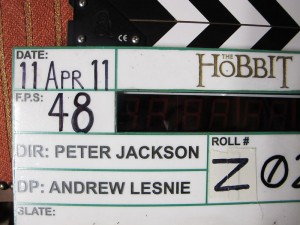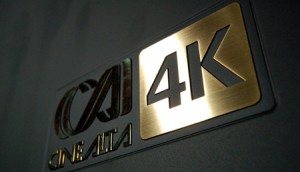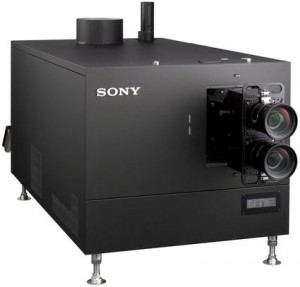 Today’s CinemaCon presentation of 10 minutes of 48-frame-per-second 3D footage from The Hobbit has unleashed quite the fire storm on film blogger twittersphere (which is like, I dunno, thirteen trees falling in the forest and there are, you know, six or seven dudes there to hear them), with reactions seeming to range from “this will be divisive” to “this will rape children.”
Today’s CinemaCon presentation of 10 minutes of 48-frame-per-second 3D footage from The Hobbit has unleashed quite the fire storm on film blogger twittersphere (which is like, I dunno, thirteen trees falling in the forest and there are, you know, six or seven dudes there to hear them), with reactions seeming to range from “this will be divisive” to “this will rape children.”
While there seems to be a nearly universal agreement that 48fps makes watching a 3D film a more comfortable experience, the larger emphasis has been on how the exceptional clarity does — to many people’s eyes at least — strip the footage of a certain “cinematic quality.” Jackson has acknowledged the shift and suggested that even film purists become converts after being exposed to it for a while, but already I’m seeing heels being dug into the dirt for a long, vocal resistance to this change. I have a feeling it could make the 3D debate look positively tame, which is a truly exhausting thought.
48fps of course represents a two-fold increase in the number of images per second being thrown into your eyeballs, and it has the affect of decreasing one’s perception of motion blur, frame jutter, and other effervescent artifacts of traditional 24fps cinema. For 3D the extra information helps comfort the eyes, reduce ghosting and other uncomfortable phenomenon, but whether in 2D or 3D the added frames unarguably alter the fundamental “look” of a film. Since I was not present, I can’t judge how the specific footage shown today looked*, but any search on twitter or eye kept on film blogs over the next 24 hour will get you plenty of eyewitness accounts.
But as interesting as it may be to watch professional film critics evangelize one way or another about film tech — which is kind of like listening to sports broadcasters commentate on a game that  hasn’t been played yet — your bigger concern is likely to be “when the fuck do I get to see it for myself?”
hasn’t been played yet — your bigger concern is likely to be “when the fuck do I get to see it for myself?”
Considering this footage was shown for theater owners at CinemaCon, you may figure that there’s a lot of politics, negotiating, and lengthy conversion ahead for theaters, much as there has been for 3D. That’s absolutely true, but whether theater owners at the presentation were impressed or not, wide access to 48fps isn’t going to be a huge variable. The basic fact is that by the time The Hobbit is released at the end of the year, most anyone that has access to any sort of chain cineplex will be able to give the technology a shot.
You see, 3D was (and remains) a lengthier conversion process because even theaters with digital projectors needed to convert and add equipment, meanwhile 35mm facilities had a ground-up replacement process ahead of them. That same thing is true for most of the digital projectors out there, but as THR has reported, tech companies are already beginning to offer relatively manageable upgrade boxes that allow older machines to process 48fps footage for projection. For example, these will allow the nearly 50,000 Christie Series 2 projectors (one of, if not the most common digi projectors there is) to be upgraded for, say, 10k rather than +120k for a whole new system. How many of them will be upgraded is up in the air, but the fact is that some will be, and any of them used in a major theater are likely to be among them.
More importantly, the +13,000 Sony Digital 4k systems that are spread across the world are already capable of natively projecting 48fps. AMC for example –the second largest theater chain in the US — has long had a deal inked to have every projector in every auditorium converted to  Sony 4Ks by the end of this year. Other major chains employ these same Sony machines or have similar deals in place for these units, which make showing even a 48fps The Hobbit trailer doable right this minute, and even more universally in December. If you visit major movie theaters often, you’ve probably already seen a movie on one of these (beautiful) projectors. In fact (and this is something I have to check on), I believe these particular projectors are already capable of projecting in 60fps- which is a standard James Cameron is pushing for us to eventually reach.*
Sony 4Ks by the end of this year. Other major chains employ these same Sony machines or have similar deals in place for these units, which make showing even a 48fps The Hobbit trailer doable right this minute, and even more universally in December. If you visit major movie theaters often, you’ve probably already seen a movie on one of these (beautiful) projectors. In fact (and this is something I have to check on), I believe these particular projectors are already capable of projecting in 60fps- which is a standard James Cameron is pushing for us to eventually reach.*
Now granted, that doesn’t mean everyone everywhere will have 48fps screenings available to them, but the availability should be something close to the availability of 3D when Avatar hit- which is to say: more than enough.
I would suspect that any grander push towards total 48fps capability in theaters is going to take much longer, as the public is not likely to respond to the technology in anyway that makes it a premium-charge worthy upgrade. So basically the tech will ride in on the coat-tails of already-in-progress conversion for 3D, rather than prompting its own push. There’s also the fact that there are no other major films currently in production that will require 48fps, so The Hobbit is going to remain a unique technological curiosity for some time. When Avatar hit, there was already a glut of 3D flicks (converted and otherwise) waiting in the wings. With Avatar 2 at least three years off, I’m not even sure what would follow up The Hobbit in this format in the next few years. Without the obvious profit potential, I doubt studios will be mandating 48fps anytime soon, and I’m not sure how many major creatives other than Jackson there are that Cameron has been able to convince.
What many of you will read from all this is the happy counter point: 48ps screenings should also be exceptionally easy to avoid. Not everyone is going to be on board with this new tech, and while in some places it’s getting tough to find 2D 35mm showings of new release blockbusters, there should be a wide variety of options for consumers when it comes Hobbit time. As for Avatar 2 or Pirates 5 or whatever blockbuster next decides to shoot in 48fps (or 60fps) next, I can’t say what the scary future will be like at that point…
Twitter
Comment Below
Message Board
*I’m excited to see the tech, even with the negative reactions. I’m the guy who will systematically go through and turn off 120hz on every demo TV in a store if whoever I’m with doesn’t drag me out first, so I’m all about movies “looking like movies.” The thing is, I’m going to have a much different eye for a film natively shot in the format, rather than watching an old movie on a TV that’s making shit up to increase clarity.
**Jackson decided to ease into HFR for now, but 60fps is considered the highest frame rate at which humans can discern a difference in their persistence of vision. It also has the advantage of down-framing to 48fps and 24fps natively.